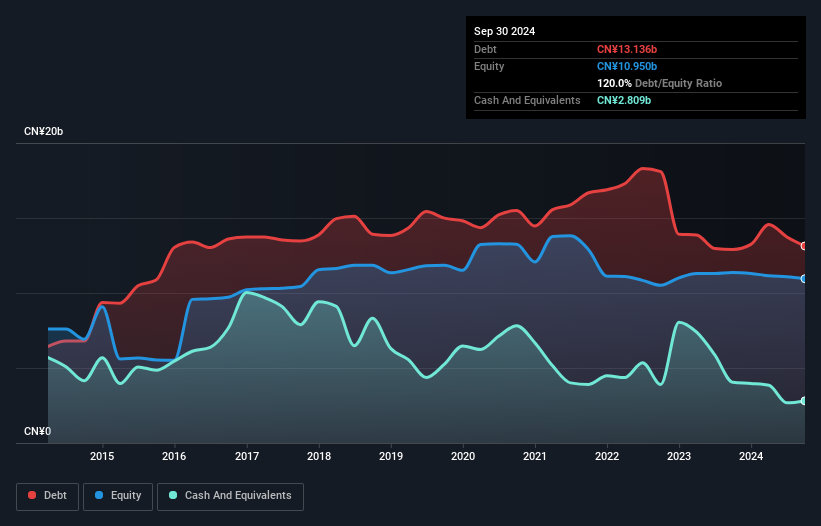- China
- /
- Real Estate
- /
- SHSE:600748
These 4 Measures Indicate That Shanghai Industrial DevelopmentLtd (SHSE:600748) Is Using Debt In A Risky Way
David Iben put it well when he said, 'Volatility is not a risk we care about. What we care about is avoiding the permanent loss of capital.' So it seems the smart money knows that debt - which is usually involved in bankruptcies - is a very important factor, when you assess how risky a company is. Importantly, Shanghai Industrial Development Co.,Ltd (SHSE:600748) does carry debt. But the real question is whether this debt is making the company risky.
Why Does Debt Bring Risk?
Generally speaking, debt only becomes a real problem when a company can't easily pay it off, either by raising capital or with its own cash flow. Part and parcel of capitalism is the process of 'creative destruction' where failed businesses are mercilessly liquidated by their bankers. However, a more usual (but still expensive) situation is where a company must dilute shareholders at a cheap share price simply to get debt under control. By replacing dilution, though, debt can be an extremely good tool for businesses that need capital to invest in growth at high rates of return. The first step when considering a company's debt levels is to consider its cash and debt together.
See our latest analysis for Shanghai Industrial DevelopmentLtd
What Is Shanghai Industrial DevelopmentLtd's Net Debt?
The chart below, which you can click on for greater detail, shows that Shanghai Industrial DevelopmentLtd had CN¥13.1b in debt in September 2024; about the same as the year before. On the flip side, it has CN¥2.81b in cash leading to net debt of about CN¥10.3b.

A Look At Shanghai Industrial DevelopmentLtd's Liabilities
According to the last reported balance sheet, Shanghai Industrial DevelopmentLtd had liabilities of CN¥6.94b due within 12 months, and liabilities of CN¥11.6b due beyond 12 months. Offsetting these obligations, it had cash of CN¥2.81b as well as receivables valued at CN¥332.4m due within 12 months. So its liabilities outweigh the sum of its cash and (near-term) receivables by CN¥15.4b.
The deficiency here weighs heavily on the CN¥6.38b company itself, as if a child were struggling under the weight of an enormous back-pack full of books, his sports gear, and a trumpet. So we'd watch its balance sheet closely, without a doubt. At the end of the day, Shanghai Industrial DevelopmentLtd would probably need a major re-capitalization if its creditors were to demand repayment.
We measure a company's debt load relative to its earnings power by looking at its net debt divided by its earnings before interest, tax, depreciation, and amortization (EBITDA) and by calculating how easily its earnings before interest and tax (EBIT) cover its interest expense (interest cover). This way, we consider both the absolute quantum of the debt, as well as the interest rates paid on it.
Weak interest cover of 1.7 times and a disturbingly high net debt to EBITDA ratio of 13.9 hit our confidence in Shanghai Industrial DevelopmentLtd like a one-two punch to the gut. The debt burden here is substantial. Even worse, Shanghai Industrial DevelopmentLtd saw its EBIT tank 55% over the last 12 months. If earnings continue to follow that trajectory, paying off that debt load will be harder than convincing us to run a marathon in the rain. The balance sheet is clearly the area to focus on when you are analysing debt. But you can't view debt in total isolation; since Shanghai Industrial DevelopmentLtd will need earnings to service that debt. So when considering debt, it's definitely worth looking at the earnings trend. Click here for an interactive snapshot.
Finally, while the tax-man may adore accounting profits, lenders only accept cold hard cash. So the logical step is to look at the proportion of that EBIT that is matched by actual free cash flow. During the last two years, Shanghai Industrial DevelopmentLtd burned a lot of cash. While investors are no doubt expecting a reversal of that situation in due course, it clearly does mean its use of debt is more risky.
Our View
To be frank both Shanghai Industrial DevelopmentLtd's EBIT growth rate and its track record of staying on top of its total liabilities make us rather uncomfortable with its debt levels. And furthermore, its net debt to EBITDA also fails to instill confidence. Considering everything we've mentioned above, it's fair to say that Shanghai Industrial DevelopmentLtd is carrying heavy debt load. If you harvest honey without a bee suit, you risk getting stung, so we'd probably stay away from this particular stock. When analysing debt levels, the balance sheet is the obvious place to start. But ultimately, every company can contain risks that exist outside of the balance sheet. These risks can be hard to spot. Every company has them, and we've spotted 3 warning signs for Shanghai Industrial DevelopmentLtd you should know about.
When all is said and done, sometimes its easier to focus on companies that don't even need debt. Readers can access a list of growth stocks with zero net debt 100% free, right now.
New: Manage All Your Stock Portfolios in One Place
We've created the ultimate portfolio companion for stock investors, and it's free.
• Connect an unlimited number of Portfolios and see your total in one currency
• Be alerted to new Warning Signs or Risks via email or mobile
• Track the Fair Value of your stocks
Have feedback on this article? Concerned about the content? Get in touch with us directly. Alternatively, email editorial-team (at) simplywallst.com.
This article by Simply Wall St is general in nature. We provide commentary based on historical data and analyst forecasts only using an unbiased methodology and our articles are not intended to be financial advice. It does not constitute a recommendation to buy or sell any stock, and does not take account of your objectives, or your financial situation. We aim to bring you long-term focused analysis driven by fundamental data. Note that our analysis may not factor in the latest price-sensitive company announcements or qualitative material. Simply Wall St has no position in any stocks mentioned.
About SHSE:600748
Shanghai Industrial DevelopmentLtd
Develops, operates, sells, and manages real estate properties in China.
Mediocre balance sheet with low risk.
Market Insights
Community Narratives




